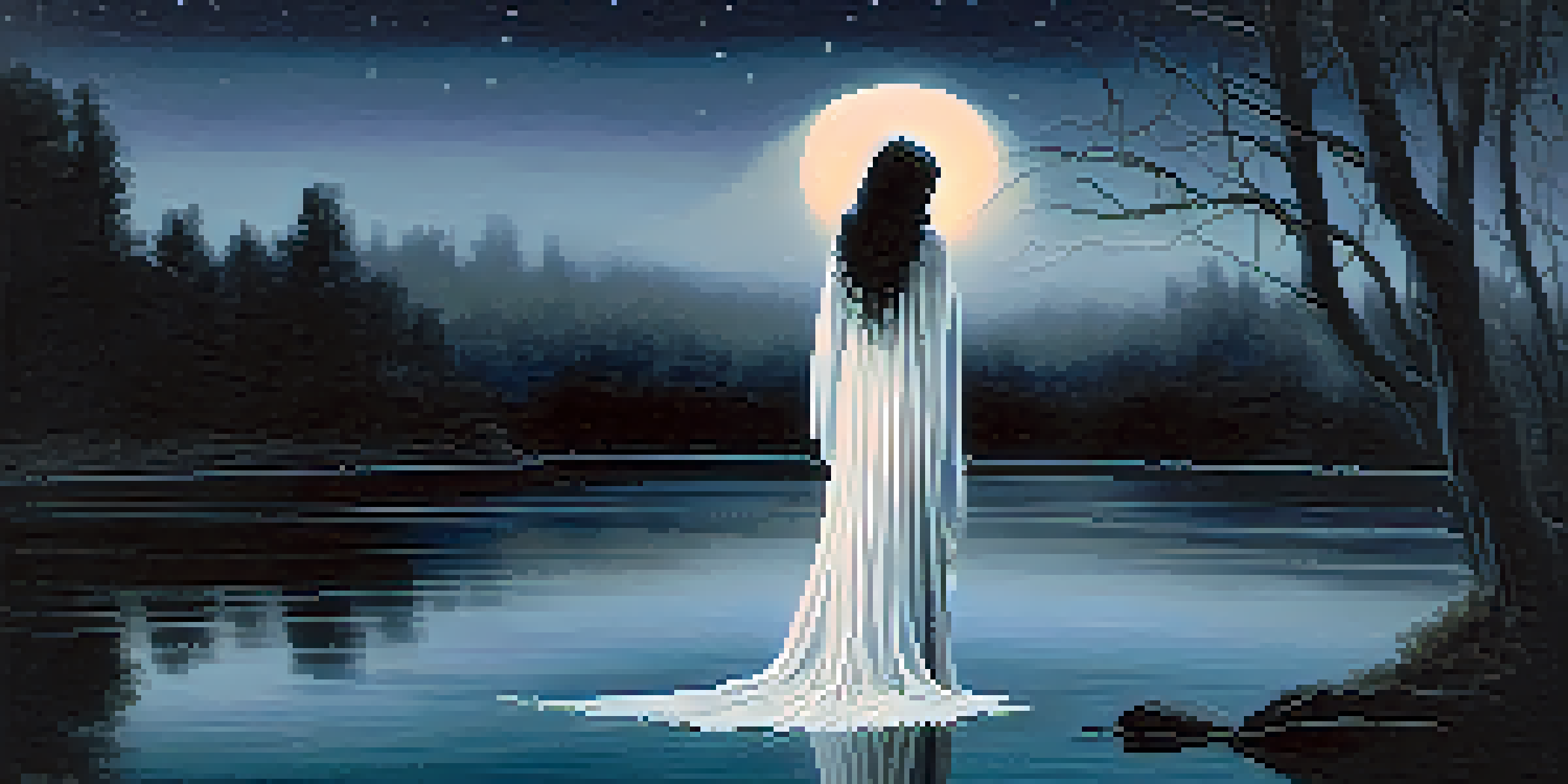The Legend of La Llorona: Weeping Woman of Spanish Folklore

Origins of La Llorona: A Tale of Love and Loss
La Llorona, or 'The Weeping Woman,' has roots that trace back to ancient Mexico. This haunting figure is often depicted as a heartbroken mother who drowned her children in a moment of despair, only to drown herself soon after. The story varies by region, but the core theme remains constant: the tragic consequences of lost love and remorse.
The greatest tragedy is to lose oneself in the process of loving someone too much, and forgetting that you are special too.
The legend serves as a cautionary tale, warning against the dangers of jealousy and neglect. In many versions, La Llorona wanders rivers and lakes, crying for her lost children, instilling fear in those who hear her wails. This sorrowful cry echoes through generations, making La Llorona a powerful figure in Mexican folklore.
Interestingly, La Llorona's story is not just a tale of horror but also a reflection of societal issues, such as the struggles of women and motherhood. Her narrative resonates with many, serving as a reminder of the emotional and psychological challenges faced by mothers and families.
Cultural Significance: La Llorona in Society
La Llorona has transcended her origins to become a symbol within various cultures, particularly in Latin America. She is often invoked in conversations about morality, family values, and the consequences of one's actions. Her story is told to children as a way to educate them about the importance of respect and caution, especially near water.

In many communities, La Llorona is seen as a protector of children, warning them to stay safe and away from danger. This duality of her character—both a figure of fear and a guardian—adds depth to her legend. As a result, La Llorona is not just a scary story but a complex cultural icon representing the struggles and fears of motherhood.
La Llorona's Origins and Themes
La Llorona embodies deep themes of love, loss, and maternal regret, reflecting societal issues faced by women.
Additionally, her influence extends into art, literature, and film, where she is often portrayed in various forms. From paintings to modern movies, La Llorona continues to capture the imagination of artists and audiences alike, proving that her legacy endures in contemporary culture.
Variations of the Legend Across Regions
While La Llorona is universally recognized, her story varies significantly from one region to another. In some versions, she is portrayed as a beautiful woman who loses her children due to her own vanity, while in others, she is a tragic victim of circumstance. These regional differences highlight the adaptability of folklore and its ability to reflect local values and beliefs.
Grief is the price we pay for love.
In the Southwestern United States, for example, La Llorona is often depicted as a spirit who haunts the local rivers, warning of the dangers that lurk in the water. In contrast, in parts of Central America, she might be seen as a more vengeful figure, seeking retribution against those who wronged her. These variations illustrate how folklore evolves to resonate with different communities.
Despite these differences, the underlying themes of loss, regret, and maternal love remain consistent. This shared essence allows La Llorona to connect people across cultural boundaries, emphasizing the universal nature of her story.
La Llorona in Modern Media: A Haunting Presence
In recent years, La Llorona has made a significant impact on modern media, appearing in films, television shows, and literature. One of the most notable adaptations is the horror film 'The Curse of La Llorona,' which brought the legend to a wider audience. This film, while taking creative liberties, highlights the enduring fear and fascination surrounding this figure.
Television series and books have also explored La Llorona's story, often reinterpreting her character to fit contemporary narratives. These adaptations help to keep the legend alive, ensuring that new generations become aware of her haunting tale. The blend of traditional storytelling with modern themes allows for a fresh perspective on the age-old legend.
Cultural Significance and Legacy
The legend of La Llorona serves as a cautionary tale about the consequences of one's actions while also acting as a protector figure in various cultures.
Moreover, the resurgence of interest in folklore and mythology in pop culture has further cemented La Llorona's place in the collective consciousness. As audiences become more curious about cultural stories, La Llorona remains a captivating character, bridging the gap between history and modern storytelling.
Psychological Themes: Grief and Regret
At its core, the legend of La Llorona delves into deep psychological themes, particularly grief and regret. Her eternal weeping symbolizes the profound sorrow that can arise from loss, resonating with anyone who has experienced similar pain. This psychological aspect makes her story relatable on a human level, illustrating how grief can consume individuals.
Additionally, La Llorona's tale serves as a reminder of the complexities of motherhood and the pressures that come with it. The emotional turmoil she experiences after losing her children reflects the struggles many mothers face, from societal expectations to personal demons. This connection to real-life emotions allows audiences to empathize with her character, transforming her from a mere ghost story into a poignant exploration of human emotions.
The themes of regret and sorrow are particularly relevant in today's fast-paced world, where many feel disconnected from their families and responsibilities. La Llorona's story encourages introspection about our relationships, urging us to cherish our loved ones and confront our feelings before it's too late.
Lessons from La Llorona: A Cautionary Tale
La Llorona's legend serves as a cautionary tale, warning against the consequences of actions taken in anger or despair. Her tragic fate reminds us that moments of weakness can lead to irreversible outcomes. This moral undercurrent is particularly impactful, encouraging individuals to think carefully about their choices and the potential repercussions.
Moreover, the story emphasizes the importance of family and the bonds that tie us together. La Llorona's sorrow stems from her separation from her children, highlighting the need to nurture and protect our loved ones. This lesson resonates across cultures, reminding us to prioritize our relationships and be mindful of the love we share.
Modern Media Adaptations
Recent adaptations of La Llorona in films and literature have kept her story alive, bridging traditional folklore with contemporary narratives.
In a broader sense, La Llorona's narrative encourages us to confront our emotions rather than let them fester. By addressing feelings of jealousy, anger, and sadness, we can avoid the kind of despair that leads to tragedy. Her story ultimately calls for awareness and compassion, both for ourselves and those we hold dear.
The Enduring Legacy of La Llorona
La Llorona's legacy is one of endurance, surviving through centuries and captivating hearts and minds across generations. Her story has evolved, yet it remains a powerful symbol of love, loss, and the complexity of human emotions. This timelessness speaks to the universal nature of her experiences, transcending cultural boundaries and resonating with people from all walks of life.
As new retellings and adaptations emerge, La Llorona continues to inspire artists, writers, and filmmakers. This ongoing interest in her story reflects a collective desire to explore the depths of human experience, reminding us of the importance of storytelling in preserving culture and history. Each new version adds layers to her character, ensuring that her story remains relevant.

Ultimately, La Llorona embodies the intricate relationship between folklore and society. As long as people continue to share tales of love, loss, and regret, her legacy will endure, reminding us of the stories that shape our identities and connect us to one another.